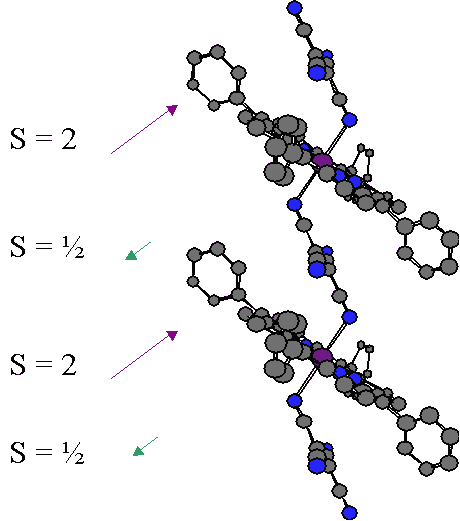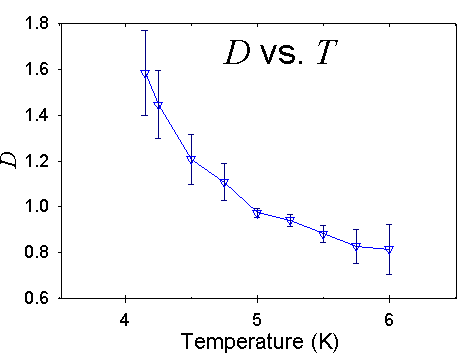
Fractal Magnets
The flexibility of organic synthesis provides the opportunity to create and control organic-based magnets with unique structural characteristics. One such example is the manganeseporphyrin family of magnets. This family of magnets forms linear chains of alternating electron donor and acceptor pairs (Figure 1). This novel structure can be adjusted by changing the organic ligands and porphyrin units allowing the tuning of the interchain and intrachain magnetic interactions. By changing the interchain interactions, a variety of magnetic ordering mechanisms can occur including spin glass behavior.

The structural properties, including the large (> 10 Å) interchain separation, suggest that the system will behave as a pure 1D
magnetic spin chain. This type of behavior is indeed seen at high (T > 60 K) temperatures. However, low temperature magnetic
data show behavior more consistent with bulk magnetic ordering, including a sizeable hysteresis at low temperatures.
Recently research in this group has focused on the nature of this spin glass state in manganese tetraphenylporphyrin (MnTPP)
tetracyanoethenide (TCNE). At low temperatures, the material begins to exhibit spin glass properties, including magnetic
relaxation. By observing the way the system relaxes upon removal of applied magnetic fields, we are able to gain insight into
the nature of this spin glass ordering.
By applying a model [Phys. Rev. Lett. 51, 1704 (1983)] which depicts the system as a collection of spin clusters having fractal
(non-integer) dimension, we are able to better understand the transition to bulk magnetic order. The way these clusters relax
upon removal of an applied magnetic field is strongly dependent on the fractal dimension of the clusters (D). Thus by observing
the relaxation of the system in both ac and dc measurements, it is possible to calculate this fractal dimension. Our results
[Phys. Rev. Lett. 89, 2027201 (2002)] show that D increases from near 1 above 5 K to about 1.5 as the temperature is lowered
(Figure 2).

These results suggest a strongly anisotropic, quasi-1D fractal cluster system. It is argued that these clusters form upon cooling the system in arbitrary directions. As the system is cooled, they begin to grow predominantly along a single chain at first. Only at the lowest temperatures do interchain correlations begin to come into play. The proposed evolution of the spin clusters can be seen in the video below.
Return to the main page
Webpage created 24 February 2003 by John Rohrbacher
Contact the webmaster